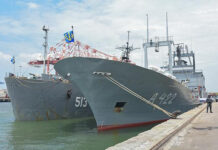The Indian Ocean island of Sri Lanka has faced many maritime disasters over the years, but none as bad as the recent incident with the MV X-Press Pearl, a freighter that caught fire on May 20 in close proximity to the western coast. The ship was transporting 1,486 containers, including 25 containers of hazardous nitric acid, 76 containers of plastic nurdles, alongside many containers with various chemicals, which also included 346 containers marked as carrying environmentally hazardous substances.
These environmentally hazardous substances have been declared as N.O.S., or “not otherwise specified.” This could include anything from toxic chemicals to heavy metals. In the absence of further research, it will not be possible to know which chemical concoction was in these containers.
With the sinking of the ship, chemicals and nurdles have spilled into the ocean.
In recent weeks, a large number of marine fauna carcasses have been making landfall around the Sri Lankan coastline, including sea turtles and cetaceans. To date, more than 250 sea turtles and more than 45 cetacean carcasses have washed ashore. It is not possible to make a full assessment of the marine life lost due to this incident and it is also difficult to fully assess the impact which can be manyfold.
Many dead sea turtles and cetaceans are carried by ocean currents to far-off places, and cetaceans especially sink to the ocean floor or are fed on by scavenger and ocean predators. This was very clear as many of the carcasses had large chunks missing, and some even had shark bite marks on them and body parts missing.

Missing body parts
Initially, when these carcasses started making landfall around the island’s coastline, it was attributed to the monsoonal winds and rough seas. However, stranding records by the current author and the whale researcher Anouk Illangakoon show otherwise.
Dead cetaceans do wash ashore during these months, however, not in such large numbers. The study of dead beached whales by Illangakoon in 2002 shows that there are two peaks in stranding events, during the months of August and November respectively. The peak in August is the culmination of an increase that starts in June. This period coincides with the southwest monsoon, when the ocean currents circulating around Sri Lanka travel from East Africa, known as the Somali Current, past Sri Lanka in an easterly/southeasterly direction — the reason why a majority of the dead animals are making landfall in the western and southern coastal belt.
Plastic nurdles
Nurdles are the pre-production building blocks for nearly all plastic goods such as bowls, pipelines and drink bottles. Once in seawater, toxic contaminants also accumulate on the surface of the nurdles or any other plastic material, as a result of prolonged exposure to seawater. The most visible and disturbing impact will be the ingestion by, and suffocation of, many marine species. Marine wildlife such as seabirds, whales, dolphins and fish easily mistake these for prey to ultimately die of starvation as their stomachs are filled with these nurdles.
Further, when marine organisms ingest plastic debris, these contaminants enter their digestive systems, and over time, accumulate in the food web. The transfer of contaminants between marine species and humans through consumption of seafood has been identified as a health hazard, but has not yet been adequately researched. These effects from the plastic nurdles are more long-term. Conversely, Sri Lankan authorities did a commendable job in cleaning up the beaches following the recent marine accident that left a trail of nurdles along the island’s western, northwestern and southern beaches.
But a large portion of these nurdles will settle on the sea bed and on the coral reefs. When coral reefs encounter plastic, the likelihood of disease outbreak is increased from 4% to 89%. With a large amount of nurdles, we can assume that it will eventually leave a catastrophic impact on our coral reefs.
Out of the five sea turtle species recorded in Sri Lanka, there are confirmed records of four species washing ashore following the MV X-Press Pearl incident: olive ridley (Lepidochelys olivacea), hawksbill (Eretmochelys imbricata), leatherback (Dermochelys coriacea) and green turtle (Chelonia mydas). The majority of deaths have reportedly been of olive ridleys, also the most common species in Sri Lankan territorial waters. There have also been suspected loggerhead turtle (Caretta caretta) deaths.
Many of the turtle bodies that made landfall showed indications that they had died due to oxygen starvation, as their mouths were agape and bleeding, and the carapaces of some showed burn marks. In some cases the scutes were bleached and shedding. On healthy individuals, shedding is only observed as the shell expands to facilitate the growth of the turtle. But shedding can also be observed when an individual has bacteria, parasites, algae infections or is faced with environmental issues. Where necropsies were done, the results showed that the animals were healthy animals, and they had food in their digestive tract. This may be indicative of unexpected deaths possibly due to exposure to highly toxic chemicals.
Generally, turtles that get washed ashore are either victims of fisheries bycatch, collision with boats/rocks, or dynamite fishing. However, the animals that have washed ashore to date did not bear signs of being victims of such deaths.
Many species of cetacean, too, have been washing ashore dead. As with the turtles, these animals, too, did not show signs of death due to fisheries-related activities or collision, which is the case in small cetaceans that are found dead in Sri Lanka. With the onset of the fire and subsequent partial sinking of the MV X-Press Pearl, many small cetaceans washed ashore dead, increasing in number gradually as the days passed. Analysis of the specimens and the species showed that they, too, were healthy animals but bore signs of exposure to extreme heat and chemicals.
At the beginning, the species of the cetacean family that washed ashore were near-shore species such as the Indian Ocean humpback dolphin (Sousa plumbea) and spinner dolphin (Stenella longirostris). However, as time passed the species that started to wash ashore dead were animals that hang around the continental shelf and beyond, such as Fraser’s dolphin (Lagenodelphis hosei), pantropical spotted dolphin (Stenella attenuata), striped dolphin (Stenella coeruleoalba), dwarf sperm whale (Kogia sima), pygmy sperm whale (Kogia breviceps) and either a melon-headed (Peponocephala electra) or pygmy killer whale (Feresa attenuata).
There were reports of a blue whale (Balaenoptera musculus) making landfall on the northern island of Kayts. It was a calf between 6.4 and 7.3 meters (21 and 24 feet) in length. The necropsy showed that the animal had an empty stomach and this was due to either being separated from the mother or falling sick. These also could be attributed to the MV X-Press Pearl incident. The calf could have separated from the mother due to the explosion on board the ship or other factors such as exposure to chemicals.
Additionally, research shows the majority of dead cetaceans (drift whales) don’t make landfalls, but are fed on by other marine organisms, and eventually sink to the ocean floor. As such, this is only a minute number of deaths of cetaceans that we see from this incident but with a likelihood of the numbers eventually being at least fourfold, or higher.
These incidents compounded together with the cargo on board the MV X-Press Pearl clearly show that the deaths of sea turtles and cetaceans are due to exposure to highly toxic substances, or due to the concoction of many chemicals and other toxins. This compounds the threats manyfold.
Multiple risks
It is necessary to take adequate action to ascertain the cause of death of these animals, especially as there is reason to believe that the majority died due to chemical contamination. Generally, chemicals/toxins absorbed by whales, dolphins and porpoises end up being stored mainly in their fatty tissues known as blubber. The levels of chemicals/toxins in an animal’s blubber will build up over time as it consumes more and more contaminated fish or experiences exposure to toxins. In times of stress, such as periods of food scarcity, these animals tend to break down their stores of blubber to provide them with an energy supply. Thus, the breaking down of blubber in this way releases a flood of toxic chemicals into their body, which can lead to death.
In this instance, these animals appear to have died within a short span of time or probably after immediate exposure to these chemicals or toxins. As such, this shows the potency of the chemicals/toxins on board or the result of many chemicals/toxins reacting together to create a highly potent substance.
Tissue samples from lungs, liver and cerebral cortex should be analyzed to identify which chemicals/heavy metals these cetaceans and turtles were exposed to get a better understanding of what we are dealing with. These chemicals/heavy metals accumulated through the food chain inevitably enter human bodies as well.
It is prudent for Sri Lanka as a nation to invest in modern laboratories and infrastructure as the trade in commercial products increases globally and more and more shipping fleets will be deployed to transport such goods. Hence, Sri Lanka is likely to experience more such disasters in the future as she sits in one of the busiest shipping lanes in the world that links Southeast Asia to the rest of the world.
– Ranil P. Nanayakkara is a conservation biologist and sustainable tourism specialist working in Sri Lanka. A member of the IUCN/SSC Sirenia Specialist Group, Nanayakkara is the co-founder and principal scientist at Biodiversity Education and Research (BEAR) and takes time off to conduct workshops on responsible whale watching in a bid to create awareness among tour operators and whale watchers and runs a sloth bear conservation initiative in Wilpattu, in northern Sri Lanka.
Published in Mongabay





